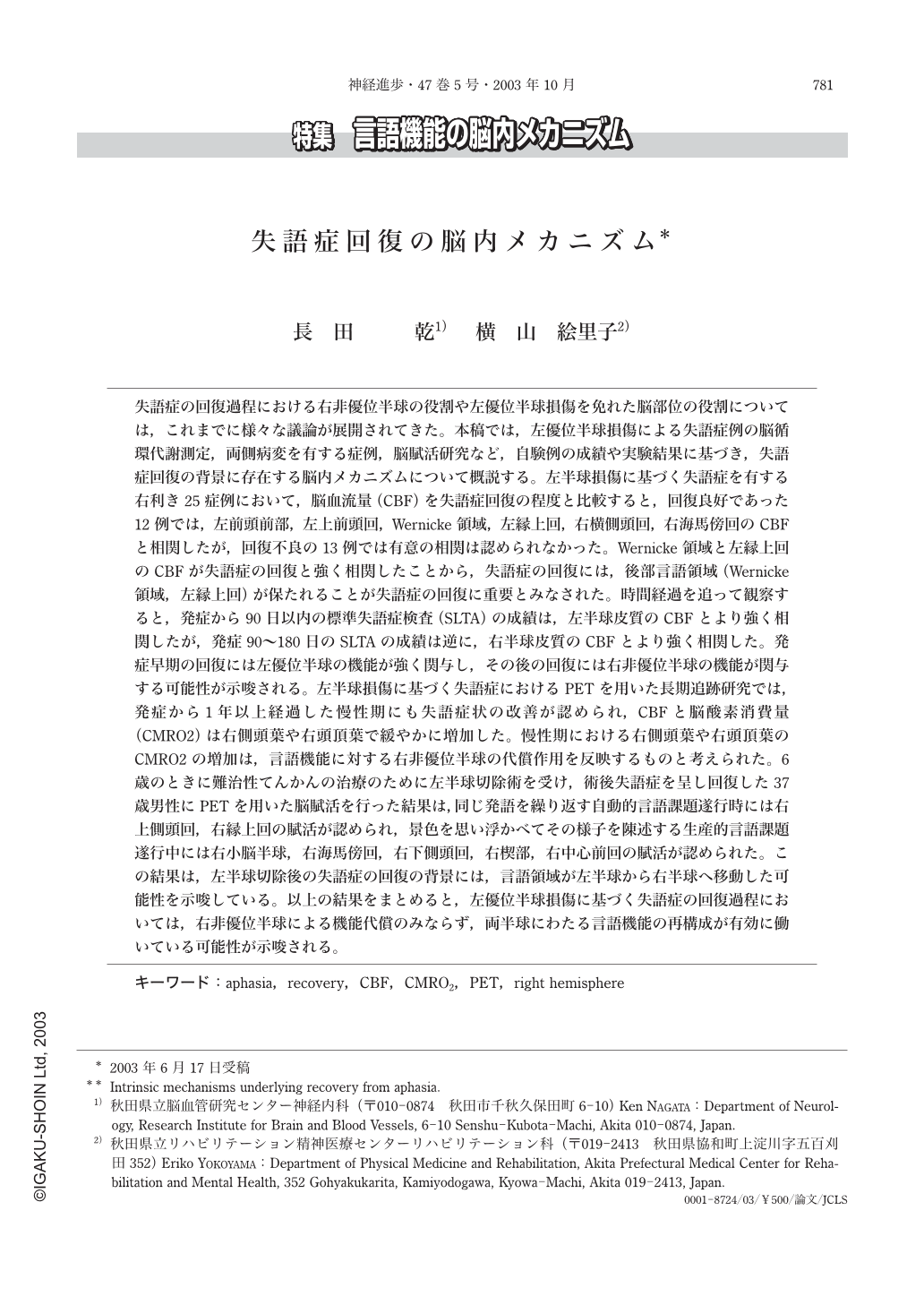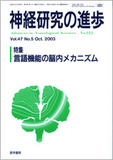Japanese
English
- 有料閲覧
- Abstract 文献概要
- 1ページ目 Look Inside
失語症の回復過程における右非優位半球の役割や左優位半球損傷を免れた脳部位の役割については,これまでに様々な議論が展開されてきた。本稿では,左優位半球損傷による失語症例の脳循環代謝測定,両側病変を有する症例,脳賦活研究など,自験例の成績や実験結果に基づき,失語症回復の背景に存在する脳内メカニズムについて概説する。左半球損傷に基づく失語症を有する右利き25症例において,脳血流量(CBF)を失語症回復の程度と比較すると,回復良好であった12例では,左前頭前部,左上前頭回,Wernicke領域,左縁上回,右横側頭回,右海馬傍回のCBFと相関したが,回復不良の13例では有意の相関は認められなかった。Wernicke領域と左縁上回のCBFが失語症の回復と強く相関したことから,失語症の回復には,後部言語領域(Wernicke領域,左縁上回)が保たれることが失語症の回復に重要とみなされた。時間経過を追って観察すると,発症から90日以内の標準失語症検査(SLTA)の成績は,左半球皮質のCBFとより強く相関したが,発症90~180日のSLTAの成績は逆に,右半球皮質のCBFとより強く相関した。発症早期の回復には左優位半球の機能が強く関与し,その後の回復には右非優位半球の機能が関与する可能性が示唆される。左半球損傷に基づく失語症におけるPETを用いた長期追跡研究では,発症から1年以上経過した慢性期にも失語症状の改善が認められ,CBFと脳酸素消費量(CMRO2)は右側頭葉や右頭頂葉で緩やかに増加した。慢性期における右側頭葉や右頭頂葉のCMRO2の増加は,言語機能に対する右非優位半球の代償作用を反映するものと考えられた。6歳のときに難治性てんかんの治療のために左半球切除術を受け,術後失語症を呈し回復した37歳男性にPETを用いた脳賦活を行った結果は,同じ発語を繰り返す自動的言語課題遂行時には右上側頭回,右縁上回の賦活が認められ,景色を思い浮かべてその様子を陳述する生産的言語課題遂行中には右小脳半球,右海馬傍回,右下側頭回,右楔部,右中心前回の賦活が認められた。この結果は,左半球切除後の失語症の回復の背景には,言語領域が左半球から右半球へ移動した可能性を示唆している。以上の結果をまとめると,左優位半球損傷に基づく失語症の回復過程においては,右非優位半球による機能代償のみならず,両半球にわたる言語機能の再構成が有効に働いている可能性が示唆される。
はじめに
失語症の回復は,単に臨床的な機能の評価や予後の予測にとどまらず,脳の可塑性や言語機能局在など,多彩な観点から研究が推し進められている。
脳損傷からの回復は,もっぱら急性期にみられる組織損傷の修復など,生物学的機転を中心としたいわばハードウエアの回復と,それ以降に起こる機能の再構成・再分配やネットワークの再構築など,ソフトウエアの回復に大別することができる。たとえば脳卒中からの回復過程を例にとると,発症から数日あるいは数週間の第一段階では,脳浮腫の消退,壊死組織の吸収,血管新生,血腫の吸収,側副循環の発達などや,生理的活性物質の放出や遺伝子表現の変化などの生化学的変化が起こり,損傷組織の修復が進む。こうした生物学・生化学的変化については,動物実験により詳細な解析がなされている。一方,発症後数週間を経過した時点からも機能の緩やかな回復が起こることは周知の事実であるが,機能的な抑制からの解放,周辺領域や対側半球の機能の関与など様々な仮説が提示されているが,いまだ不明な点が多く残され,現在もなお最新の方法論を駆使した臨床研究や脳賦活実験が展開されている。
脳損傷からの回復を考えるときに,完全回復から重症例の不十分な回復まで様々な程度の回復を含めて,残存領域がいかに代償機能を補うかというメカニズムを理解することが重要な意味を持つ。左半球に言語機能が局在するというBrocaの報告以来すでに140年余り経過しているが,左半球損傷に基づく失語症からの回復における,右半球の役割については,なんらかの言語機能あるいは代償機能の可能性は強く示唆されているものの,いまだ十分な説明は得られていない。
本稿では,失語症からの回復を支える脳内メカニズムについて,自験例の成績を交えて概説する。
The respective contribution of the right non-dominant hemisphere and the residual areas of the damaged dominant left hemisphere in the recovery from aphasia has been a matter of discussion. We reviewed the possible intrinsic mechanisms underlying the recovery from aphasia based on clinical and experimental evidences:laterality studies in aphasics, patients with bilateral lesions, neuroimaging and brain activation studies. When the local CBF was correlated with the degree of recovery from aphasia in 25 aphasics with left-hemisphere lesion, the left prefrontal, left superior frontal, Wernicke's, left supramarginal, right transverse, and right parahippocampal corices were associated with the recovery in 12 patients with good recovery, whereas no significant relationship was observed in 13 patients with poor recovery. The stronger correlation between the Wernicke's and supramarginal cortices and good recovery suggested that preservation of the posterior language area was crucial in the favorable recovery from aphasia. The language ability evaluated earlier than 90 days after onset correlated closely with the left cortical CBF, whereas that evaluated between 90 and 180 days correlated more closely with the right cortical CBF. In the long-term follow-up study with positron emission tomography(PET)in aphasics with left-hemisphere lesion who showed some recovery from aphasia in the chronic stage, there was a gradual increase in cerebral blood flow(CBF)and cerebral metabolic rate of oxygen(CMRO2)in the temporal and parietal cortices on the right hemisphere more than one year after the onset. The late increase in CMRO2in the right temporal and parietal cortices may indicate a possible compensatory role of the right hemisphere during the recovery from aphasia. In the activation study with PET in 37-year-old man who had undergone a left-hemispherectomy for the treatment of intractable seizure when he was 6 years old, the right cerebellar hemisphere, right parahippocampal and inferior temporal gyri, right cuneus, and right precentral gyri were activated during productive speech, where the right superior temporal and supramarginal gyri during automatic speech. These results confirmed a shift of the language areas from the left to the right hemisphere after the recovery from aphasia due to the left hemispherectomy. From these results, it is suggested that during the recovery from aphasia due to unilateral left-hemisphere lesion, a bilaterally re-organized language network may function more effectively than a right-hemisphere predominant compensatory activity.

Copyright © 2003, Igaku-Shoin Ltd. All rights reserved.


